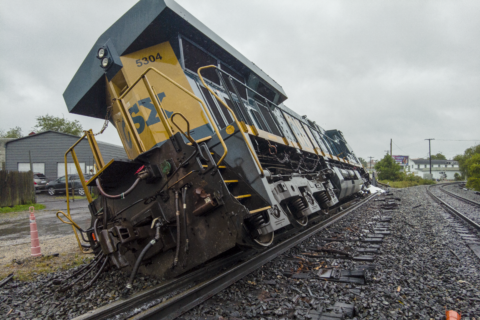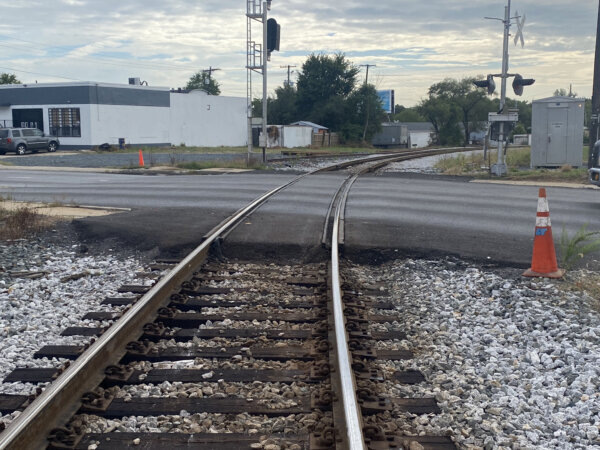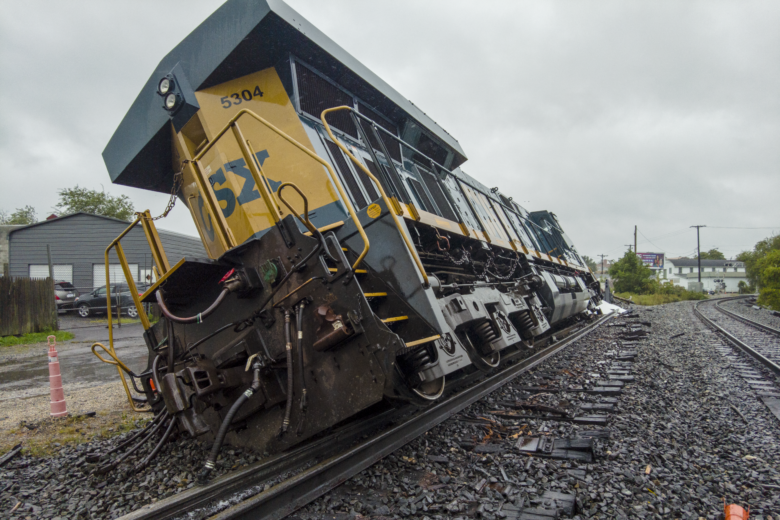
It was about a year ago that a train derailed as it crossed over Baltimore Avenue in Hyattsville, Maryland, shutting down the road for weeks and scattering cargo. The mess itself is long gone, but a road adjacent to the tracks remains torn up and the cost of fixing it has been one of the sticking points in the dispute the city has had with CSX.
Nevertheless, the city continues to breathe a sigh of relief, even though the derailment led to pellets and nonhazardous materials spilling out of the train.
A train carrying toxic chemicals, in an area with many residential, commercial and industrial buildings could have had a much harsher impact. There’s also lessons the city of Hyattsville and other municipalities have learned, too.
Local emergency management leaders will train for all sorts of disasters, but at the municipal level, train derailments hadn’t been one of them. There are a lot of municipalities in the county that have railroad tracks running through them.
“From a municipal perspective, it’s a little difficult sometimes for a smaller or even mid-sized municipality to deal with something of this nature,” said Reggie Bagley, emergency operations manager in Hyattsville.
Since the derailment last year, Hyattsville has also forged closer ties with the county to better coordinate in the future — all the way down from initial response to managing a scene when busy roads, like Baltimore Avenue/Alternate Route 1, get impacted.
“We had to solicit the help from our neighboring municipalities to help provide policing, support, traffic calming — those types of things,” said Bagley.
About 15,000 cars drive that stretch of Alternate Route 1, which carries traffic from downtown Hyattsville toward the Bladensburg Peace Cross and the Route 50/New York Avenue areas.
“There was a lot of rerouting of traffic that was necessary, and our officers just weren’t able to handle it all. So, we were fortunate to be able to reach out to some of our neighboring municipalities who provided police support. But, of course, there’s a cost that comes with that, and so they’re looking to be reimbursed for all of their expenses that they did to help out the issue here,” he said.
Hal Metzler, the deputy director of public works for the city of Hyattsville, who spoke during a briefing to the Prince George’s County Council on Tuesday, said the county’s public works staff wasn’t trained to prepare for these types of incidents.
“Communication, again, is key,” Metzler said. “Many agencies don’t seem to have publicly available information on who to contact in these types of incidences.”
But Bagley said that’s no longer the case now.
“I’m glad to say that particularly the Office of Emergency Management has been very aggressive in terms of getting the municipalities together,” Bagley told WTOP from the scene of the now repaired tracks.
“We’ve had a couple of convening sessions, gone through some tabletop exercises, because it doesn’t just have to be a train. It could be anything. It could be a weather-related emergency, it could be a fire, it could be any type of thing that a municipality would not be able to handle,” he added.

So what happened?
A year later, it’s still not entirely clear exactly what happened to cause the derailment.
The Federal Railroad Administration conducted an investigation, but would only produce the report through a Freedom of Information Act (FOIA) request. So far, that request is still pending, but the general findings blame a track defect for the derailment, which is the cause of most derailments.
It occurred on a stretch of track that curves off a parallel course going north next to Route 1 and eventually goes back south on the other side of the Anacostia River toward D.C. again. It was caught by surveillance cameras in the area, but since it happened in the overnight hours, no one got a clear view.
“We were able to see the sparks. We were able to see where it actually initiated,” said Bagley. “We don’t want to speculate, get ahead of the investigation to find out exactly what the cause was, but we could see that there was something that happened on the track.”
Ultimately, several rail cars were knocked off the track, and the track itself, as well as a city-owned road next to the tracks, was damaged. Part of the long restoration effort was replacing the track bed that was damaged.
Today, a stack of extra track bed is adjacent to the scene, in case repairs are ever needed again.
Bagley said it’s not clear if the track was damaged by the derailment, or if damaged track caused the derailment.
He described the initial response from CSX as quick, effective and cooperative. But while massive cranes needed to upright the tumbled rail cars arrived quickly, CSX was forced to stage on a road that couldn’t handle the weight and so it significantly damaged.
The repairs, estimated to cost hundreds of thousands of dollars, still haven’t been completed yet. However, a deal on the reimbursement for that, as well as the cost of the response in terms of extra police and public works personnel, isn’t nearly as far away compared to just a couple of days ago.
“It looks like we’re very close to an agreement, if not almost there,” said Bagley. Significant progress was made in the negotiations late Wednesday evening, he said.
“By this time in the next few days, we should be all remunerated for all of our issues that we had in terms of the obligations we incurred as a result of the derailment,” he added.
Multiple requests for comment from CSX have not been answered, but on Tuesday, Bagley told the Council, “the longer we wait to get it settled, the higher the cost goes.”
“Every time we ask for a contractor estimate to do that roadway repair, of course, time goes on, costs go up,” he added. “So, the $300,000 is up from what it was initially, and so the longer it takes it (the higher it goes).”
“We’re looking forward to being able to repair those (tracks) and get everything back to like it should be,” Bagley said.
Get breaking news and daily headlines delivered to your email inbox by signing up here.
© 2024 WTOP. All Rights Reserved. This website is not intended for users located within the European Economic Area.









